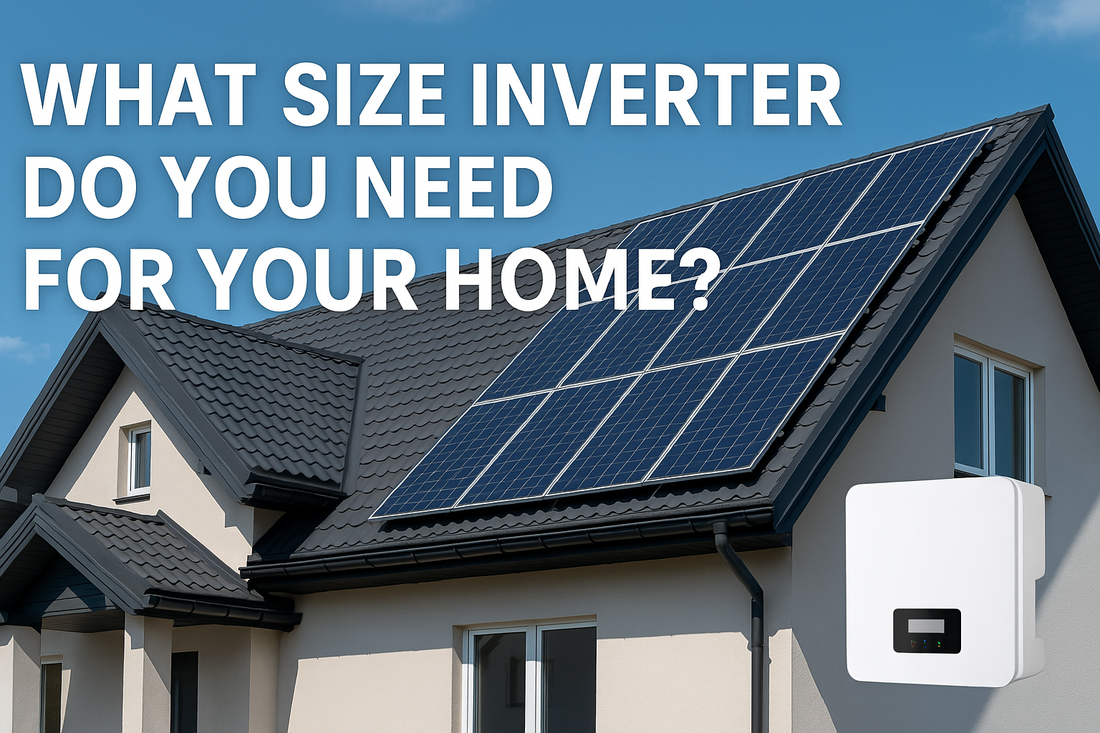An inverter plays a pivotal role in any residential energy system especially in solar-powered, off-grid, or backup power setups. It converts direct current (DC) typically sourced from solar panels, batteries, or generators into alternating current (AC), which is the standard form of electricity used by household appliances.
Choosing the right inverter size is essential to ensure system efficiency, device compatibility, and uninterrupted power delivery. An undersized inverter can lead to system overloads or power failures, while an oversized unit may result in unnecessary cost and energy waste.
In this guide, we’ll walk you through the steps to accurately calculate your home’s total power demand and select an inverter that best matches your energy usage patterns and lifestyle needs.
Calculating the Total Wattage of Your Home’s Appliances
Before choosing an inverter, you need to assess how much power your household consumes. This involves calculating the total wattage of all devices you intend to power using the inverter.
🔍 How to Calculate Total Load:
1. Create a Load Inventory
List every appliance and electronic device you plan to run starting with essentials like:
- Refrigerators
- Lights and fans
- Televisions
- Computers and mobile chargers
2. Then include intermittent or high-demand devices, such as:
- Microwaves
- Washing machines
- Coffee makers
- Air conditioners or water pumps
3. Identify Power Ratings
Check each device’s wattage typically found on the nameplate, user manual, or online specification sheet.
4. Daily Usage Calculation
Multiply each device’s wattage by its average daily usage time to get the energy consumption in watt-hours (Wh).
Example: A 40W bulb used for 5 hours/day = 200Wh/day
5. Account for Starting/Surge Power
Appliances with motors or compressors (e.g., air conditioners, pumps, and refrigerators) draw a higher surge wattage during startup often 2–3 times their running power.
- Always include peak power requirements in your calculations to avoid inverter overload.
6. Add a Safety Margin
Once you’ve totaled your expected power usage, add a 20–25% buffer.
This accounts for:
- Sudden load spikes
- Future device additions
- Minor inefficiencies in the system
This initial load assessment is crucial. It ensures you select an inverter that not only meets your current demand but also scales with future expansion delivering reliable, uninterrupted power without system stress or failure.
Determine the Type and Number of Batteries Required
Once you’ve calculated your home’s total daily energy consumption, the next critical step is selecting the right battery setup to support your inverter system. Batteries store the energy that your inverter will convert into usable AC power so choosing the correct type, size, and quantity ensures your system performs reliably, especially during outages or off-grid conditions.
🔋 Understanding Battery Types
There are several battery technologies available for home energy systems, each with its pros and cons:
1. Lead-Acid Batteries (Flooded or AGM):
- Lower upfront cost
- Shorter lifespan (~3–5 years)
- Heavier and larger
- Lower Depth of Discharge (DoD): ~50%
2. Lithium-Ion Batteries (LiFePO₄):
- Higher efficiency (90–95%)
- Longer cycle life (up to 10+ years)
- Lighter, more compact
- Higher DoD (80–100%)
- More expensive, but cost-effective long term
Pro Tip: For residential use, lithium-ion batteries are typically preferred due to their efficiency, longevity, and ease of integration with modern solar and inverter systems.
What Size Inverter Do You Need?
Choosing the correct inverter size is essential for powering your home's electrical loads safely, efficiently, and without interruption. Inverter size is measured in watts (W) and must match or exceed the total wattage of the devices you intend to power plus an additional buffer to accommodate power surges and future load growth.
🔌 Why Inverter Sizing Matters
An inverter’s job is to convert DC electricity (from batteries or solar panels) into AC power, which is what most household appliances use. If the inverter is undersized, it won’t be able to run all your devices especially if several are operating at once. If it’s oversized, it may waste energy and result in higher system costs.
⚡ Key Inverter Ratings to Consider
1. Continuous Power Rating (Watts)
- This is the maximum power the inverter can supply continuously.
- It should match or slightly exceed your total running load.
2. Surge (Peak) Power Rating
- Many appliances, particularly those with motors or compressors (e.g., refrigerators, air conditioners, pumps), require a surge of power often 2–3 times their rated wattage when starting up.
- Your inverter must handle these short bursts without overloading or shutting down
📏 Sizing Guideline Example
Let’s say your total running load is 1,500W, and your appliances require a surge capacity of up to 3,000W. You would need an inverter that offers:
- ≥ 1,500W continuous power, and
-
≥ 3,000W surge capacity (usually for 5–10 seconds)
In this case, a 2,000W pure sine wave inverter with a 4,000W surge rating would offer both reliability and flexibility.
📌 Pro Tips for Inverter Sizing
- Add a 20–25% margin to your total load to ensure flexibility and long-term scalability.
- Make sure the inverter matches your battery voltage (e.g., 12V, 24V, or 48V).
- Choose a pure sine wave inverter for sensitive electronics and modern appliances.
- If you plan to expand your system (e.g., add solar panels or appliances), size your inverter with future loads in mind.
Your inverter is the heart of your home power system. Proper sizing ensures it performs efficiently, handles all connected loads, and adapts to changes in your household’s energy usage.
How to Select the Right Inverter for Your Home’s Energy Requirements
Choosing the right inverter is critical to optimizing your home’s energy system. While inverter wattage is important, there are several other factors such as efficiency, compatibility with energy sources, and scalability that play a significant role in the inverter's performance. An ideal inverter should align with your energy consumption patterns, provide room for system expansion, and deliver efficient operation.
⚡ Is Your Inverter Efficient Enough?
Efficiency is one of the most important factors when selecting an inverter. A highly efficient inverter minimizes the energy lost during the DC-to-AC conversion process, ensuring that more of your stored or generated energy is used effectively. Typically, you should aim for an inverter with an efficiency rating of 90% or higher to ensure optimal performance.
Why Efficiency Matters:
- Reduces energy waste and improves overall system performance.
- Prolongs battery life by minimizing unnecessary power drain.
- Lowers energy costs by maximizing the usable energy from your storage or solar system.
🔎 Consider the No-Load Power Draw
The no-load power draw refers to the amount of energy the inverter consumes when it's on but not actively powering any appliances. A lower no-load draw indicates a more efficient inverter, which is especially important in systems that run continuously or for backup purposes. This feature can lead to significant energy savings over time.
💡 Efficiency in Real-World Use
It’s essential to evaluate the inverter's efficiency under a variety of load conditions, not just its peak performance. A high-efficiency inverter that operates well across different load ranges can provide more consistent performance and greater adaptability to your changing household energy demands.
🔧 Key Features to Look for in an Inverter:
1. Power Capacity – Ensure the inverter can handle your total energy demand, plus a buffer for peak power.
2. Efficiency Rating – Look for 90% or higher efficiency to optimize energy usage.
3. Surge Capacity – The inverter should be able to handle brief power surges from appliances like refrigerators and air conditioners.
4. Adaptability for Expansion – Consider future upgrades or additions to your energy system, ensuring the inverter can scale with your needs.
Final Considerations
Choosing the right inverter isn’t just about the wattage rating it’s about selecting a system that meets your current needs while offering future scalability and optimal efficiency. By factoring in these key considerations, you ensure your home’s energy system is reliable, cost-effective, and ready to handle future energy demands.

